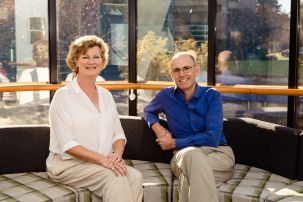University of Canterbury legal academics are researching the legal issues faced by businesses and residents in Wellington after a major earthquake.
Professor John Hopkins and lecturer Toni Collins are members of a study Regulating for Resilience in an Earthquake Vulnerable City: the Wellington case. Both are associate investigators of QuakeCoRE, the New Zealand Centre for Excellence in Seismic Resilience at the University of Canterbury.
Their QuakeCoRE-funded project, Addressing Wellington Multi-Story Existing Buildings – Regulatory Solutions for Addressing Earthquake Vulnerable Commercial Buildings, poses the question: How do we regulate to make Wellington more resilient?

Dr Toni Collins and Professor John Hopkins.
The interdisciplinary project, to be completed by the end of 2020, began with engineering, then social sciences, and now law.
“We’re mapping law around resilience and looking for methods to improve things for businesses and residents. Our focus is on multi-story buildings. We tend to consider whether a building is earthquake-vulnerable rather than earthquake-prone,” says Professor Hopkins.
“Law and Disasters is a new legal speciality in New Zealand. After the Christchurch quakes there was a lot of legal confusion which affected people’s ability to be resilient. The problem for Wellington is the existing buildings. We ask people: ‘Where do you want to be on the day after the disaster?’ We need to set up structures and incentives to get us to where we want to be,” he says.
“People are not always aware of the rules and vulnerability of their buildings. They think that by signing a lease they are signing up to a ‘safe’ building. Unfortunately, when buildings are assessed those buildings have not always had their non-structural elements included in the process, such as windows and décor.”
Dr Collins’ research focuses on the problems for commercial tenants and landlords after quakes, especially involving the central business district and the use of cordons, which stop people accessing dangerous buildings and other areas that may pose a risk to the public.
“How do we cordon the central business district in a way that will keep Wellington accessible and operational? What powers are required to do that and what happens when a state of emergency lapses? How do we protect the disabled, the elderly and children who also use the city. It’s important to be able to model what can be expected for particular groups?” says Dr Collins.
“Wellington has only two access points; both need to be kept enabled for the city to survive as a city after a major quake. Wellington’s geography puts the city’s survival in more doubt than was the case for Christchurch where outlying areas provided access around the red zone.”
The researchers say that among the legal issues that need further consideration are those concerning contracts, insurance, property, employment, education, crime and human rights.
